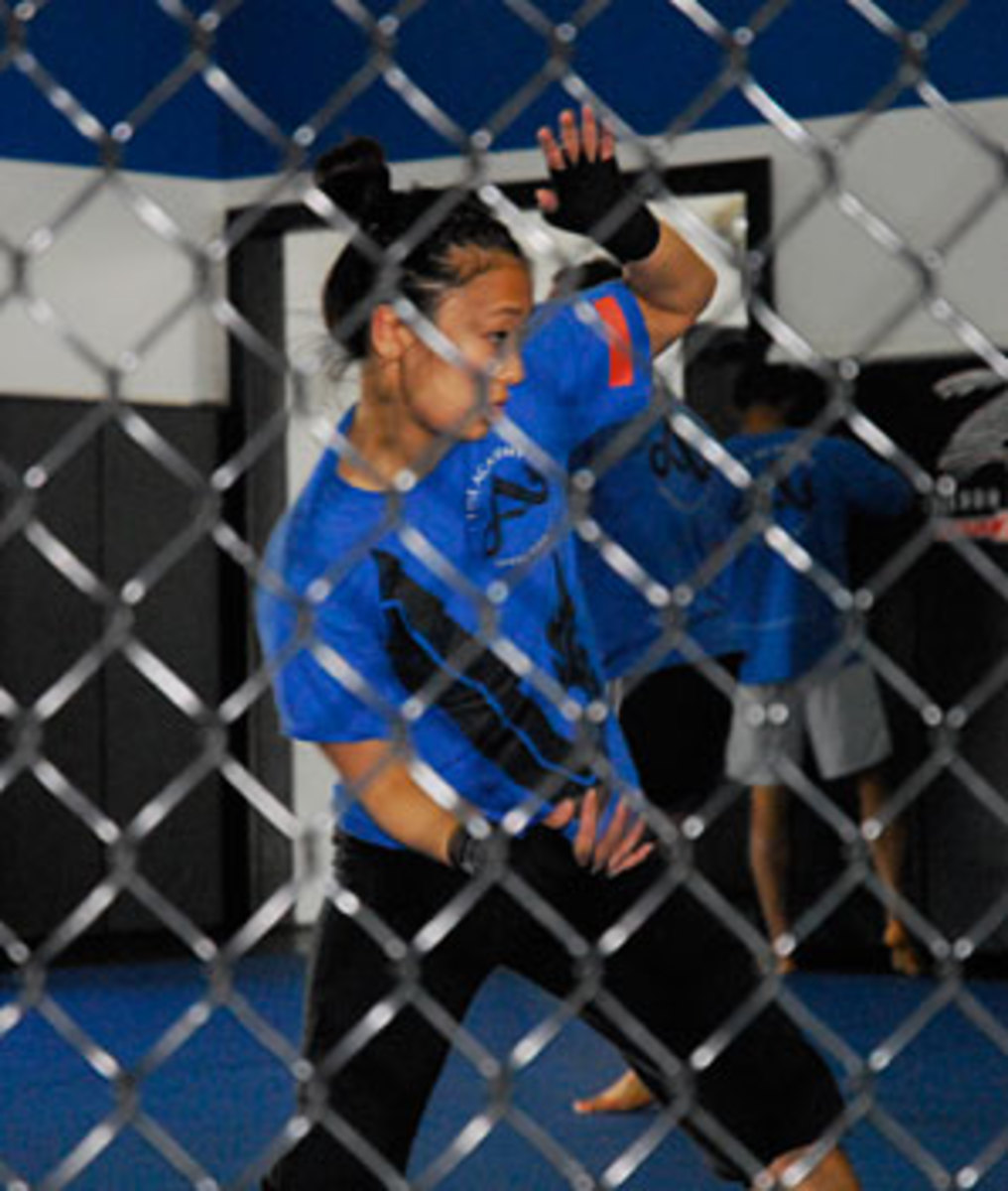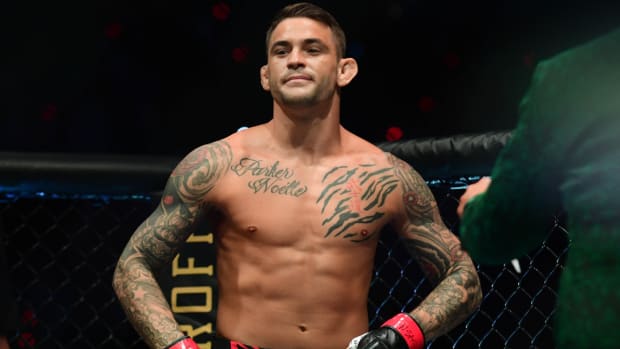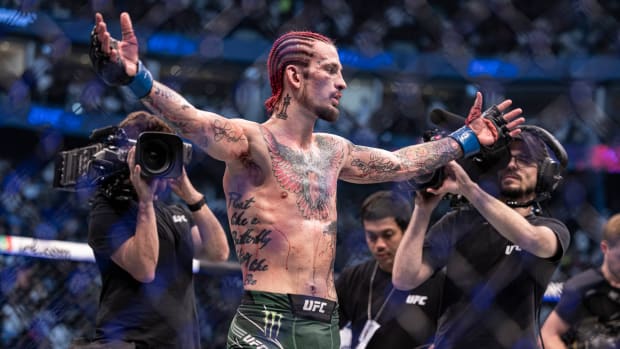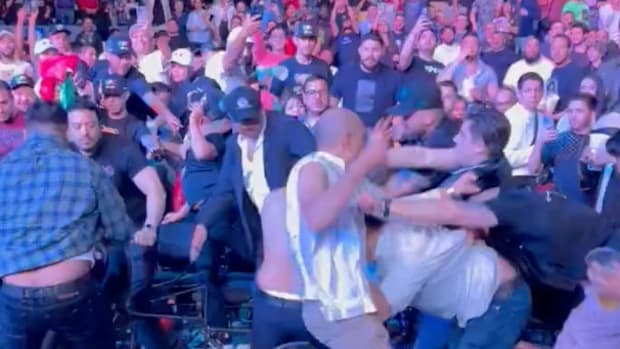Army combatives tourney offers arena for gender-equality fight
Army National Guard guardsman Kailey Carlson, a diminutive PhD candidate in psychology who plans to specialize in treating female vets affected by rape and post-traumatic stress syndrome, is being slapped in the face by a male guardsman. Her comrades, looking on, do nothing as the man wraps his arm around her neck, choking her. And when advocates for rights of women in the military learn of Carlson's beatdown, they cheer.
That's because Carlson's fight happened within the confines of a military combatives competition last March at Fort Benning, Georgia. Carlson is one of 16 women who have qualified -- often by going head-to-head, fist-to-fist against male soldiers -- for the All-Army Military Combatives Tournament this weekend at Fort Hood, Texas. The combatives tournament tests the hand-to-hand fighting skills of 321 of the Army's toughest soldiers. Though combatives combines skills like jujitsu, wrestling, boxing and looks like MMA in camoflauge, Matt Larsen, who wrote the Army's combatives field manual in 2002, cautions that combatives is not MMA.
"Combatives is not a sport. It's a training method to teach soldiers not only hand-to-hand combat but teach them how to be warriors," he says. "It's more about inculcating an ethos and a skill set than anything else. In MMA, the arena is the point. But for us, the arena is only a training ground. The real fight is a real fight down range. The only value the arena has for us is that it's motivational to get people training."
Among those most motivated to train are a growing number of women, morphing the combatives competition into a proxy battle of a different sort: A dispute over women's roles in combat. Combatives challengers like Carlson square off with male counterparts in military competitions with nothing more than a 15 percent weight allowance in their favor. "We can't go to the Taliban and tell them we're looking for a 140-pound female to fight our female," says Kris Perkins, an Army vet now in charge of the Fort Hood combatives program.
These men-versus-women combatives challenges occur as the military engages in the largest overhaul of women's duties in recent decades. In March 2011, a congressional panel recommended the Pentagon lift a longstanding ban prohibiting women from combat duty. The military rejected the committee's proposal but opened 14,000 jobs previously closed to women on a trial basis and began work on a new line of combat gear designed to accommodate the wider hips, breasts, an other anatomical differences of its servicewomen. The U.S. Marine Corps announced in April that the branch would allow women to attend its prestigious and grueling infantry officer training school. In May, Command Sergeant Major Jane P. Baldwin and Colonel Ellen L. Haring filed a lawsuit in federal court against senior military leadership for excluding women from combat roles based solely on their sex. The suit alleges, among other claims, that female service members are often disqualified from senior leadership positions because they lack combat service.
The ban on women in combat stems mostly from doubts about women's physical capacity to endure the rigors of the front lines. Which, of course, explains why the women-on-men combatives challenges like the All-Army Combatives Tournament take on added significance. "Women's full and visible participation in this Tournament -- and in actual combat theaters -- shows, without a shadow of a doubt, that the combat exclusion policy rests on outdated stereotypes and not on 'real' empirical differences between males and females," writes University of Law Professor Anne Coughlin, whose research served as the basis for Baldwin and Haring's lawsuit. "Now, with this new evidence of women's fitness, we don't have to scratch our heads over the question of whether the differences alleged to support the combat exclusion policy are real or merely created by outmoded ways of thinking about women's fitness. Female soldiers themselves -- with the full knowledge and tacit support and encouragement of their commanders -- are proving that the alleged differences are immaterial and provide no sensible basis for the classification."
Yet female qualifiers in this year's All-Army Combatives Tournament interviewed by SI say they enter combatives competitions as a personal challenge not a political statement. Carlson, 27, who served as a mess hall cook in Iraq from 2007 to '08, says she watched the Minnesota Guard's combatives state tournament two years ago and told one of her commanders, "I want to be here next year." Two days later, with her commander's encouragement, Carlson made her way to a training session at Camp Ripley near Little Falls, Minn. The morning after her workout, she struggled to grip her clothes as she tried to get dressed. "I was using muscles you don't know you have and I hurt in places where you don't even know you have muscles," she says. But she was hooked. "I just fell in love with it. It's so humbling because it doesn't matter how big you are, how small you are, there's always someone better than you are. You can't discount somebody just based on how they look. There's always something they can teach you."
Carlson now spends five days a week, three hours per day, spreading her time between muay thai, jujitsu and grappling techniques. She remembers feeling uneasy the first time she slapped an opponent in the face but says, "as soon as you get slapped in the face, you're not nervous anymore."
At her match in Fort Benning, her opponent managed to break her guillotine hold and eventually placed her in the an arm bar ("the longest arm bar I've ever been in," she says. "It was nasty") and beat her with a rear-naked choke. After the fight, her opponent approached her to say, "I was a little nervous at first."
Kelsey De Santis, who was the only female combatives instructor during her service at the United States Marine Corps prestigious Martial Arts Center for Excellence, says male reactions to their female opponents fall into two distinct categories. "There's the no-way-I'm-going-to-hit-a-girl guy and there's the no-way-I'm-going-to-let-a-girl-knock-me-out guy," she says. De Santis says the chivalrous men vex her more than her overly aggressive opponents. With the I'm-No-Going-To-Let-A-Girl-Knock-Me-Out guys, DeSantis says, "I would usually use their momentum against them." But the ones who didn't want to hurt her? "I'd have to hit them hard enough to make them hit me back."
Nothing frustrates Staff Sergeant Julian Spottedbear, a 33-year-old drill sergeant and female competitor representing Missouri's Fort Leonard Wood in this year's All-Army Combatives Tournament, more than an opponent who won't hit her. "When I'm down there, I want someone to go full force on me. Don't feel back because I'm a female. If you punch me in the side, I'm OK with it but sometimes I'll get little taps on the side and I'm thinking, 'Is that it?' My expectation is that's what it's going to be and it takes away from my training if you don't give me the full effect."
Spottedbear's Fort Leonard Wood teammate, Shaiyla Hakeem, a drill sergeant from Youngstown, Ohio, who served as a military police officer for one year at Guantanamo, recalled a recent bout when she noticed her male opponent wasn't wearing a mouth guard. "Who goes into a fight without a mouth guard? I took it as, this guy thinks this fight is going to be easy because I'm a female." Hakeem placed her mouth guardless opponent in a guillotine to start the match, neared a choke out but ended up losing the bout by one move in a judge's decision. After the fight, her mouth her opponent's coach approached her and said, "You did good -- for being a female."
Organizers say they have no plans to separate the competitions into male and female divisions. It would violate one of the military's central ethics: A soldier is a soldier. Perkins, Fort Hood's combatives director says he often hears female combatives competitors say they don't want a separate division. "I hear that they would rather be third in the [overall] tournament than first in a women's tournament. They want to know where they stand in the Army not among the females in the Army."
Carlson says the mixed-gender competitions were what attracted her to the team. "The big reason I wanted to be on the combatives team was that I can fight no matter what gender. It's where I can show what I can do."
But Carlson, along with Spottedbear, Hakeem, and De Santis, each stopped short of equating their ability to fight with men in the ring with their right to fight on the front lines with their male comrades. A woman has yet to reach the final round of in seven years of All-Army Combatives Tournaments.
Perhaps because of their fighting experience, female competitors express nuanced views on the roles of women in combat. "If we can meet the demands, if there's absolutely no changing the standards, there shouldn't be an issue," Carlson says. "Do I see myself breaking down that barrier? No, I don't."
De Santis, who finished her five-year service with the Marines last January and is pursuing a professional MMA career, says her experiences as an instructor make her hesitant to advocate placing women on the front lines with the Marine Corps. No woman had been able to complete a specialized, seven-week, hand-to-hand combat course at the Martial Arts Center for Excellence. "I'm a female fighter and I'm all about female rights but I've pushed myself to my limits and beyond," she says, "But [men and women], physically, they are two different body types. To offer up, to force females into that [combat] field, isn't a good idea. But on a positive note, I see it progressing. I see more women trying to focus and learn in the mixed martial arts."
And no where is that uptick more evident than this weekend at Ft. Hood The army combatives specialty clothing line, RangerUp, has seen an 85 percent increase sales in its female apparel, driven by women like Spottedbear, Hakeem, and Carlson. "This is such a thinking sport," Spottedbear says. "You're constantly thinking of your next move."
As Spottedbear thinks of her next move on the mat, military leadership is no doubt pondering its next play on the battlefield with women like her, as they turn the combatives cage into a petri dish for female warriors. "Imagine what it's like whenever a female gets in the arena with a man and she starts to lose," says Larsen. "It's a fight. He's on top of her, punching her in the face. You have to be hardened to the idea -- you have to really believe -- that women can be treated equally to be able to put up with that. To accept that as the cost of equality."






